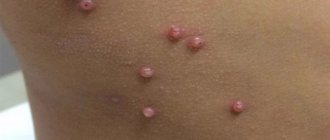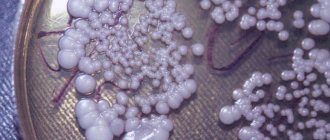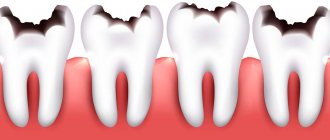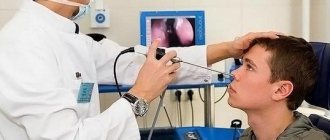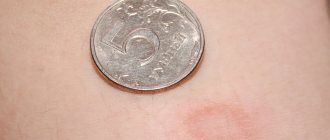Neoplasms that appear on visible parts of the body make any person worry and assume the worst diagnoses. When such a problem occurs, you should not immediately think about the most negative prognosis: in most people, tumors on the skin are benign. This category also includes atheroma, located in different parts of the body. The second name of the disease is more understandable and familiar to many people – wen. This skin formation can be located on almost any part of the body, but most often atheroma develops on the head, face, neck and back. Atheroma on the back, due to its location that is difficult for visual inspection, is detected late, due to which it can grow to large sizes.
Types and causes of formations
Atheroma is a benign formation that develops as a result of blockage of the sebaceous glands. Due to the blockage of the ducts, sebum is not secreted, but is produced further and accumulates in the subcutaneous layer, forming a capsule around it.
There are two types of atheromas:
- Genetic. They develop during the intrauterine formation and maturation of the epidermis (the disease is hereditary).
- Untrue. Formed when the sebaceous gland is clogged throughout a person’s life, they represent a sac containing atheromatous masses.
Atheroma in the back area is not true; it can appear in a person of any gender and age category, but more often men after 30 years suffer from this disease. The reason lies in the accelerated release of testosterones.
There are many factors that can provoke the development of cysts under the skin. These include:
- Disturbed metabolic processes. Against the background of some pathologies, a change occurs in the nature of the separation of the glands from the sebaceous glands, which causes the ducts to become clogged.
- Increased sweat production. This phenomenon is often observed when there is a hormonal imbalance. A person becomes prone to pimples, acne rashes, and furunculosis.
- Skin injuries.
Causes
All the reasons that predispose to the appearance of a wen on the back can be divided into two categories. The first group of possible causes of atheroma development includes factors acting from outside:
- Injury to the sebaceous gland and its duct. Most often, microtrauma is caused by a broken hair: it stops growing, and the sebaceous duct continues to produce its secretion, due to which the hair follicle grows.
- Adverse weather conditions: constant exposure to high temperatures, excess humidity. Wearing a synthetic outer shirt that does not allow air to pass through in such a climate increases the risk of developing atheroma.
- Work that involves staying in a hot and stuffy room.
Wen can also develop under the influence of internal reasons, these include:
- The most likely internal provoking factors include hyperhidrosis, that is, increased hyperfunction of the sweat glands. Excessive sweating also affects the formation of more secretion from the sebaceous glands.
- Diseases occurring with metabolic disorders.
- Hormonal imbalances. Often this factor leads to the appearance of atheromas on the back in adolescents, predominantly males.
- Recurrent acne.
- Oily seborrhea of the trunk.
Symptoms
An epidermal cyst on the back can be recognized by the following signs:
- a lump-like compaction on the back between the shoulder blades, along the spinal column or in the lumbar region,
- the skin over the tumor is not damaged, its shade does not differ from the surrounding skin (unless the cyst is inflamed),
- the formation can be the size of a “pea”, and sometimes grows to the size of a “chicken egg”,
- atheroma is characterized by an increase in volume,
- the formation has a round shape, soft to the touch, inactive,
- there is no pain during palpation examination,
- there is no itching or other similar signs,
- in the center of the formation there is a black dot - this is a blocked duct,
- in some cases, spontaneous opening of the cyst, suppuration, and removal of the contents is observed,
- the accumulated exudate during squeezing of the opuole can be released in the form of a white cheesy mass with a characteristic aroma,
- when the atheroma becomes inflamed and suppurates, the secretion becomes yellowish or brown with bloody inclusions,
- an opened cyst can fester and transform into an ulcer.
Atheroma on the head: causes of appearance and treatment methods with and without surgical removal + Photo
Atheroma is a benign neoplasm that usually forms on the scalp. It looks like a lump and appears due to disruption of the sebaceous glands.
While it grows, it does not cause any inconvenience to a person at all. It's just more difficult to comb.
However, this lump can burst at any time, which will lead to complications and worsening of the person’s condition. We’ll tell you in the article how to deal with it and whether it can be cured at home.
Have you noticed a bump on your head?
You urgently need to see a doctor! What could it be? Perhaps this is atheroma or, as people call it, a wen.
According to experts, a bump on the head is formed due to the fact that the sebaceous glands are clogged. Liquid accumulates in the resulting lump. with an unpleasant odor of yellow color and cheesy consistency. It contains epithelial cells, sebaceous secretions, dead keratinized cells, and cholesterol.
The skin on the wen is no different from normal skin. The atheroma itself is slightly mobile. The person does not experience pain when pressing on the wen. However, if you accidentally damage it, for example, while scratching your head, you can get an infection.
And this can lead to unpleasant consequences, for example, to sepsis of the subcutaneous layer of the head. And this, in turn, leads to a deterioration in a person’s condition, the appearance of fever, headache, increased temperature and a drop in blood pressure.
Doctors note that atheroma, barely noticeable at first, can grow to the size of a chicken egg.
This happens because its contents cannot leave the capsule, gradually accumulating. But it can take a long time to grow. There are cases of congenital atheroma, when it does not change in size throughout life.
Either one or several atheromas can form on the head.
There is no need to wait until the lump grows to an impressive size. After all, even though it is a benign formation, it can give complications and fester at any moment. For example, such a bump on the back of the head can reduce vision.
At the first signs of atheroma, you should consult a doctor. It is he who will make the diagnosis and determine whether it is definitely a wen. The fact is that atheroma is similar in appearance to lipoma, fibroma, and dermoid. Treatment will be different in each case.
Attention. The fatty tissue should not be squeezed out. This can lead to blood poisoning.
Risk group for atheroma
Doctors note that a similar disease occurs in women, men and even children. Men, by the way, suffer from the appearance of atheroma more often. They tend to eat fattier foods and often neglect hygiene procedures.
Practice has shown that atheroma is formed due to blockage of the sebaceous glands, disruption of the hair follicles, rupture of the sebaceous gland, high testosterone levels, carbunculosis or furunculosis.
People who sweat frequently
Those who suffer from acne and seborrhea are at risk. In addition, the appearance of a bump on the head is influenced by genetic predisposition and various endocrine diseases, for example, diabetes. In addition, those who have hormonal disorders need to be very careful.
Visitors to beauty salons
Those who often dye their hair, perm their hair, or constantly blow-dry their hair are also at risk of developing a bump on their head. Nervous stress and chronic stress can also lead to the formation of a wen.
Fat lovers
Atheroma forms in those who consume a lot of fatty, spicy and salty foods. Abnormal development of the sebaceous glands, in which the composition of the sebaceous secretion thickens and the ducts themselves narrow, can also lead to the appearance of a lump.
Wen can also occur in children
Doctors say that such cases occur in every second baby. Such bumps develop from epidermal cells and are not considered pathological.
The active work of the sebaceous glands leads to the growth of the lump. As a rule, in children, atheroma looks like a pinpoint rash of white color with a pearlescent tint. The skin around the nodules can become inflamed and sometimes fester.
A baby with such symptoms should definitely be seen by a doctor. He will determine further treatment. As a rule, if there is no inflammatory process, then atheroma in children is not treated. It goes away on its own over time. But during the inflammatory process, rashes are treated with antiseptics.
Indications for removal
Doctors definitely say no. Even if the wen does not hurt or itch, it is necessary to get rid of it as soon as possible. Moreover, surgically.
At any moment, any careless movement can damage the skin and cause infection. Then it will be more difficult to cope with the consequences.
Treatment options
Atheroma is treated in several ways.
Laser
The lump can be removed with a laser. This treatment is used in the early stages of development. During the operation, the lump is opened, the cavity is treated with a laser, removing all the contents. The surface of the skin is then cauterized. Advantages of the laser: the wound from the operation heals quickly, and relapses are practically not observed.
Surgery
If the lump has reached a large size, a surgical method can be used. During the operation, the cyst along with the membrane is removed using a puncture. With this method, there are no postoperative scars left on the skin. And the procedure itself lasts no more than 15 minutes.
When performing operations with these two methods, it will be necessary to remove hair in the area where the lump forms.
Radio wave method
There is a third way in which this is not required. This is a radio wave method. During the operation, a radio knife removes the lump along with its contents. With this option, there are no postoperative sutures or scars, and the postoperative period is very short.
Doctors often stop at this method of treatment.
Histology
The material removed during surgery is sent for histological examination to determine the nature of the tumor and exclude the development of cancer. This is a prerequisite for such operations.
Is it possible to use folk remedies?
Experiments in this case will not lead to anything good. By resorting to grandma's recipes, a person can not only waste precious time, but also aggravate the situation.
For example, some people apply lamb fat to the lump. This is not worth doing. After all, atheroma itself is formed due to blockage of the sebaceous glands. Adding foreign fat can only cause harm.
Recipes with garlic, which is also recommended for use in the treatment of atheroma, can cause unnecessary irritation on the skin. Herbs, for example, such as coltsfoot, may soothe the skin. But there is no talk of getting rid of the lump.
The most important thing is that you don’t have to try to squeeze out the lump yourself.
Some use Vishnevsky ointment. It can be applied to the site of formation of the wen for several hours and evaluate the result. If there are no changes, you need to consult a doctor: a dermatologist or surgeon.
Important! There is no need to use traditional medicine recipes in the fight against atheroma. In this case, only a surgeon can help.
Is it possible to prevent the appearance of atheroma?
Experts say yes. To do this, you must observe the rules of personal hygiene, do not forget to take a shower, and wash your hair more often.
It is necessary to select the right shampoos and balms in accordance with the type of skin on the head.
It is better to use cosmetics with herbs. If your scalp is oily, you need to use a shampoo that reduces the production of sebaceous secretions.
Doctors also strongly advise not to overuse hair dyeing and perming, and not to use a hot air dryer. And if you use this type of styling, then not often.
You should not delay the treatment of chronic diseases, try to live without stress and stop smoking and drinking alcohol.
Even an incorrectly chosen headdress can contribute to the formation of atheroma. In winter you should wear a warm hat, and in summer you should wear a light hat or Panama hat. By the way, people who already have a bump on their head should definitely wear a Panama hat in hot weather. The fact is that the sun's rays can contribute to the growth or even disruption of the integrity of atheroma.
The diet also needs to be reviewed. To prevent the formation of atheroma, it is necessary to reduce fatty foods, spicy and salty foods from the menu. Animal fats can be consumed, but in small quantities.
It is better to drink milk and eat fruits. This will allow the body to receive the necessary vitamins and boost immunity.
Healthy! Fatty and spicy foods, as well as frequent styling and coloring of hair contribute to the appearance of atheroma.
Source: https://iplastica.ru/kosmetologia/novoobrazovaniya/shishka-na-golove-ateroma.html
What is the danger of festering atheroma?
Typically, a person who has been diagnosed with atheroma does not experience any discomfort, other than aesthetically. If the formation is infected, it may become inflamed and suppuration may appear. In such a situation, the patient notes the occurrence of pain during palpation examination, fluctuation, swelling and local hyperemia of the skin.
With the development of a large epidermal cyst, a person’s health worsens: the temperature rises, weakness appears, and appetite decreases. The reason for this phenomenon is intoxication of the body.
In some cases, the atheroma opens on its own. When a suppurating skin cyst is opened spontaneously or with outside help and the exudate is removed, one should not think that the problem is resolved. In such a situation, you will need the help of a doctor to remove the atheroma. If the capsule formed during the development of pathology remains in place, there is a high risk of re-formation of a cyst in the same area.
Atheroma of the scalp: causes, symptoms, treatment
Despite its apparent harmlessness, atheroma of the scalp can cause a lot of trouble. A cystic mobile neoplasm occurs completely unexpectedly. A small bump, which looks like an ordinary pimple, eventually turns into a decent “bump”.
A tumor with a serous filling enclosed in a membrane spoils the appearance, itches and causes discomfort, and then begins to pose a threat to health.
The formation of an epidermal or epidermoid cyst is associated with blockage of the ducts of the sebaceous glands.
If you are not careful and do not seek medical help in a timely manner, the atheroma can become inflamed and begin to exude pus. It happens that a neoplasm becomes a harbinger of a cancerous tumor.
Independent attempts to get rid of the tumor by squeezing or rubbing only worsen the situation. Only surgical intervention can completely get rid of it.
Why does atheroma occur?
Thanks to numerous studies, it has been found that most often atheroma is formed due to physical damage to the sebaceous gland or its ducts.
At the same time, the gland continues to produce fluid, but since it cannot reach the surface of the skin, atheroma is formed. Infection is also possible, and then you need to urgently contact the surgical service for help.
- Injury to the skin and the sebaceous glands directly;
- Being in toxic environmental conditions or working in a hazardous enterprise;
- Serious metabolic and metabolic disorders;
- Imbalance of the hormonal system.
All these factors can cause the formation of a neoplasm, and the causes of atheroma on the head are similar in both women and men.
Causes and mechanism of development
People aged 20–35 years who lead an active lifestyle are most susceptible to this disease, as they produce more sebum.
Some of the most common causes of cyst formation include the following:
- Seborrhea;
- Incorrectly selected cosmetics;
- Susceptibility to acne and other inflammatory skin diseases;
- Increased sweating, including due to wearing synthetic clothing;
- Living in regions with poor ecology;
- Too large a share of sweets, fatty and starchy foods in the diet;
- Microtrauma of hair follicles, including during hair removal or depilation;
- Unlucky heredity;
- Diseases of the thyroid gland and other endocrine organs;
- Increased testosterone levels;
- Fat metabolism disorder;
- Negligent attitude to the rules of personal hygiene.
According to statistics, men get sick twice as often as women, since they initially have higher testosterone levels.
Types of atheroma
There are only 2 types of neoplasms:
- Acquired atheroma. Statistics show that the disease can develop at any age of a person;
- Congenital atheroma. Most often it forms on the child’s head and often does not increase over the course of several months to several years.
Also, atheroma can be either single or multiple, located in different parts of the body.
Relapse Prevention
Atheromas that have festered may recur after removal. To prevent this, you need to follow simple rules of prevention:
- use scrubs and special products to cleanse the skin;
- exclude fatty, salty and fried foods from the diet;
- use shampoos with a drying effect;
- adhere to the rules of personal hygiene;
- walk more in the fresh air away from dust;
- in hazardous industries, do not neglect safety rules and protect your skin from chemicals;
- Be sure to wash off your makeup at night and go without makeup at least two days a week.
When atheroma appears, treatment consists of simple removal without the use of antibiotics or other serious drugs. Therapy for a festering cyst takes longer. If the sebaceous gland is blocked, it is worth removing it immediately, without waiting for suppuration, because such a neoplasm will not resolve on its own.
Atheroma appears due to blockage of the sebaceous gland duct. In medicine, this neoplasm is also called an epidermal cyst. This pathology can form on any part of the body, but atheroma is more often observed on the back, head, neck, and genital area. Cystic growth is divided into two types:
- Arose against the background of heredity, and were called “genetic”.
- Formed due to blockage of the sebaceous duct and representing a capsule filled with accumulated secretion of the gland. Such a growth is called “untrue”.
Source: https://bugmk.ru/bolezni/kak-ubrat-ateromu.html
Treatment methods
Let's look at how you can cure atheroma on the back using different methods.
Use of medications
For uncomplicated skin cysts, conservative treatment is usually not required. Local therapy is used if the atheroma is inflamed. Most often, anti-inflammatory and antibacterial external drugs are prescribed to help stop the development of infection. In this case it is prescribed:
- Levomekol,
- Levosin,
- Lingezin,
- Streptonitol,
- Fastin,
- Ithiol ointment.
Any of these drugs is used externally in the form of an ointment or gel to treat the affected skin areas. If necessary, an aseptic dressing may be applied.
Surgery
If the epidermal cyst is not inflamed, conservative therapy will not help in getting rid of it. In such a situation, atheroma on the back is removed surgically. Currently, there are several methods for eliminating such formations.
If the cyst has reached a large size, it is removed along with the capsule through surgery under local anesthesia. The wound is closed with cosmetic stitches, making the post-operative scar less noticeable. Re-development of pathology in such a situation is observed in rare cases.
In addition, electrocoagulation can be used to remove an epidermal cyst in the back area. Taking into account the patient’s condition and the stage of the pathology, the doctor can offer several options for curing the disease, but the patient himself will have to decide.
In the case when the atheroma on the back has festered, the formation is first opened, the contents are removed and the wound is treated using any available medications. If necessary, drainage is left. The bandage is changed every day until complete healing. It is strictly forbidden to independently treat inflamed, suppurating atheroma. In such a situation, consultation with a specialist is required.
Folk remedies
Doctors most often do not recognize the use of unconventional methods as therapy. Although some patients use remedies prepared according to folk recipes to treat atheromas, lipomas and other tumor-like seals on the skin.
To get rid of cystic formation, you can use:
- Compress with Vishnevsky ointment. The medicine can be used for suppurating atheroma. The product helps to draw out exudate from the opuoli. The compress should be replaced 2 times a day. The procedures continue until the formation spontaneously opens.
- Rhizome of lopua. The root of the plant needs to be crushed. The raw materials are poured into a container and filled with vodka in equal quantities. The mixture settles for 2 weeks. The prepared tincture is diluted with water and taken 1 teaspoon 3 times during the day.
- Mother-and-mother's foliage. Fresh leaves must be carefully washed and dried. Then squeeze the juice out of it. The resulting liquid is applied as a compress to the affected area before bed and left until the morning. Manipulations must be repeated until the opuoli completely disappears.
- Bow. The onion head is baked in a oven, then chopped using a grater. The resulting mass is mixed with laundry soap in equal ratios. The mixture is applied in the form of a bandage to the damaged area three times a day.
- Garlic. Grate the tooth and add vegetable oil to it. Mix everything thoroughly. The resulting mass is applied to the formation a couple of times a day.
With the help of these folk remedies, you can get rid of pathology in the back area, but the capsule that remains under the skin can cause a relapse of the disease. Therefore, it is better to seek help to resolve the problem from a doctor.
Is atheroma on the head so dangerous?
Atheroma is usually classified as epidermal cysts. They are formed as a result of blockage of the excretory ducts of the sebaceous gland.
The favorite place to appear is the scalp, neck and temporal lobes. This is where the sebaceous glands are most densely located.
It is a dense substance of subcutaneous fat, epidermis and cholesterol. The main difference between atheroma and fibroadenoma and lipoma is that in its center you can see a blocked duct.
Photo
In the photo below, you can see what atheroma looks like on the scalp:
Treatment of education
Since atheroma is a cyst consisting of a dense shell of the epithelium, inside of which there is a pasty substance made from a mixture of sebaceous secretions and particles of keratinized epithelium, attempts to resolve it with folk remedies or squeeze it out without surgical intervention will not be successful. Opening at home is unsafe and can lead to inflammation and suppuration of the tissue area where the atheroma was located. a doctor should deal with this problem in a hospital or operating room.
Before the operation, the specialist must finally make sure that he is dealing with atheroma and not lipoma or fibroma. To do this, it is carefully examined and palpated. In some cases, it is advisable to do a biopsy of its contents; in especially severe cases, when there is suspicion of heterogeneity, an ultrasound is performed. Only after all these measures can you begin removal.
Removal methods
There are several ways to remove scalp atheroma:
- surgically;
- using a laser;
- radio wave method.
When removing scalp atheroma in the traditional way, you first need to remove hair from the area where the operation will take place.
Then, under local anesthesia, an incision is made in the upper part of the atheroma , the contents along with the capsule are removed.
The place where she was located is thoroughly cleaned. Drainage tubes are then inserted into the wound and several stitches are placed. Then the drainage is removed, the wound heals completely. But this method is considered unreliable, since there is a risk of re-formation of atheroma due to poor cleaning of the place where it was originally located.
Small tumors no larger than 2 cm in diameter are removed with a laser, regardless of whether there is suppuration or not. To do this, under local anesthesia, the neoplasm is opened with a scalpel, the contents are removed, but the membrane is not touched.
The wound is expanded and the membrane is evaporated using a laser, then drainage tubes are inserted into the resulting void to remove excess fluid.
A bandage is applied for 1-2 weeks, then the tube is removed and after some time the wound heals, leaving behind a small scar.
The radio wave removal method removes only small cysts. During this procedure, using special equipment, the tissue surrounding the atheroma is killed in a targeted manner. As a result, it disappears, and a small crust forms in its place.
Currently, it is reasonable to choose the latter method of removal, since it is painless, quick (the operation lasts no more than 30 minutes), does not require hair removal, and there are no scars. Disadvantage: does not allow removing large atheromas.
Post-operative care
After the operation has been performed, do not forget about postoperative rehabilitation.
If the removal was performed traditionally or using a laser, antibacterial therapy is usually prescribed to avoid suppuration and inflammation of the scar.
The scar needs to be regularly disinfected and bandages changed (if any). You can wash your hair 1-2 days after removing the atheroma. After complete healing, regular hygiene of the scalp with gentle cleansers is important. For a while, you should refrain from dyeing and curling your hair, and you should also think about regulating the functioning of the sebaceous glands.
In the video you will learn how dangerous atheroma is and methods for its removal:
By its nature, atheroma is a harmless neoplasm, which, however, in the absence of proper treatment can cause harm to the human body. Its appearance indicates that there are malfunctions in the body’s functioning and you need to listen to the signals it gives.
Source: https://kozh-med.com/novoobrazovaniya/ateroma/na-golove.html
Diagnosis and treatment of atheroma on the back
Making a diagnosis is not very difficult, since the doctor only needs to carefully examine the formation and palpate it in order to determine its nature, extent and nature. Conservative treatment in this case does not give the desired effect. The only effective way to get rid of atheroma is to remove it. There are several ways to eliminate a sebaceous cyst.
Treatment is usually carried out through surgery, during which the skin is opened and the purulent contents and capsule are removed.
If there is no inflammatory process, then the atheroma can be destroyed by the radio wave method. In addition, laser removal of atheroma is actively used. Such procedures are performed under local anesthesia. In most cases, treatment is carried out by radio wave exposure, which allows not only to remove existing formations, but also to prevent the appearance of a new cosmetic defect in the form of a scar. The doctor chooses the technique for removing atheroma depending on the location and volume of the sebaceous cyst, as well as the presence of complications.

